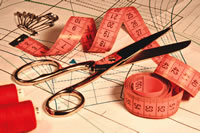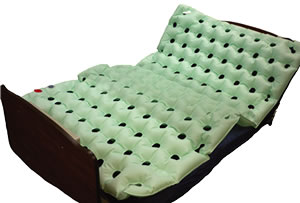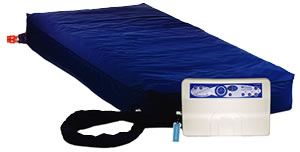Products & Technology
Tailor-Made Wound Care
Options for caring for bariatric pressure ulcer patients.
- By Joseph Duffy
- Dec 01, 2010
 Although it is difficult to secure data that addresses the percentage of bariatric patients who develop some degree of pressure sores, prevention is a top priority for manufacturers and providers who service this population. When it comes to pressure sores, bariatric patients are at greater risk due to their size and immobility. There is a greater skin to weight ratio in these patients, confounded, in many cases, by their inability to turn every two hours.
Although it is difficult to secure data that addresses the percentage of bariatric patients who develop some degree of pressure sores, prevention is a top priority for manufacturers and providers who service this population. When it comes to pressure sores, bariatric patients are at greater risk due to their size and immobility. There is a greater skin to weight ratio in these patients, confounded, in many cases, by their inability to turn every two hours.
“Obesity places extra strain on the heart and lungs to distribute oxygen and nutrients around the body,” says Sonal Patel, Associate Product Manager – Therapeutic Support Surfaces, Invacare. “The lack of oxygen and blood can result in chronic skin and wound problems. Blood supply to fatty tissue may not be adequate to provide appropriate oxygen and nutrition. In addition, obese patients are prone to profuse sweating. The moisture can cause skin breakdown and rashes that can lead to a sore.”
Fortunately for bariatric patients, technological advances continue to increase the likelihood of prevention and successful treatment. However, providers need to keep up to date on these issues and understand these technologies to give bariatric wound care patients the best possible standard of care and a fighting chance against debilitating pressure wounds.
UNDERSTANDING YOUR PATIENTS
Before providing prevention and treatment solutions for bariatric wound care patients, Patel points out there are certain aspects providers need to understand about their patients first:
- Providers must understand the options that are available for bariatric patients along with understanding patients’ needs.
- There are many mattresses with varying features. The greater the risk or the severity of a pressure ulcer, the more complex the mattress will be.
- Bariatric patients often require treatment for other co-morbidities, so a provider must account for that when choosing a mattress or other support surface. A patient may need to be turned every so often to prevent fluid buildup in the lungs. If providers know that, they will be able to choose the appropriate mattress.
- Providers should also use reliable products that will withstand the weight and pressure of the patient. Many products are made of durable materials that help prevent the breakdown of the foam or the surface.
- By assessing a patient’s situation and living space, providers will be able to ensure the sleeping area is large enough to accommodate for a larger support surface and bed. A site assessment can also give the provider the opportunity to assess other medical conditions that can help determine the correct surface the patient might need.
James Spahn, M.D., CEO of EHOB, Inc., reiterates the importance of understating your patients and having a treatment plan.
“Each provider should develop a comprehensive individualized care plan to address the bariatric patient population,” he says. “The plan should include a patient assessment upon admission, the means to address that population, and the ability to reassess the patient throughout their stay.”
With current Medicare requirements, it is essential that providers have the clinical staff necessary to discuss the needs of the bariatric patient, as well as the visiting nurse or agency handling the wound care plan, says Jim Acker, VP, Sales and Marketing, Blue Chip Medical Products, Inc.
“It is important to also know the home situation,” he says. “Does the patient live alone, or is a spouse or child responsible for the care? What physical limitations does the caregiver have? By having a better understanding of all the needs of the patient, physically, mentally and home environment, a far better assessment of equipment can be done to ensure a positive clinical outcome.”
Acker also points out that providing correct sizing and support are first steps to choosing equipment.
“Providing the proper support is critical and correct adjustment of the surface to give adequate pressure redistribution must be accomplished,” he says. “Over pressurizing of the surface can result in just the problems we are trying to eliminate. Asking clients if they are comfortable and understand that the bed is set where it must be at is critical. Education of the family and caregivers that the surface does not have to be firm to provide correct support is very important.”
TECHNOLOGICALLY SPEAKING
After gaining an understanding of the patient, the next important step in bariatric wound care treatment and prevention is knowing what’s available so you can offer patients the highest standard of care possible. This task comeswith a warning from Dr. Spahn:
“There are many companies that provide effective products to address wound care issues in the bariatric population, “ says Spahn. “However, one thing to be aware of is no one product can effectively address all patients. Matching the right product to the patient versus a patient to a product is key to effectively addressing any wound care issue. That means that providers may have to use multiple products within their facility to address pressure ulcers.”
With that said, regarding support surfaces for bariatric wound care patients, Acker recommends true low air loss alternating pressure because that technology helps keep patients dry, cool and comfortable, especially since bariatric patients have a tendency to perspire frequently.
Provider Parker B. Humphreys, CEO of H.B. Rehab Services, agrees.
“We believe true low air loss with alternating pressure is the best solution for treating pressure wounds, regardless of whether the patient is 100 lbs. or 800 lbs.,” says Humphreys. “When dealing with bariatric patients you will need a higher volume of air fl ow to counteract the increased perspiration and to adequately supply enough air fl ow to alternate pressure in the mattress.”
EHOB’s recent contribution to wound care prevention is called the WAFFLE Bariatric Mattress Overlay, a static air overlay designed for bariatric patients. According to EHOB, the WAFFLE’s diamond patterned holes naturally circulate air while allowing skin to breathe. Combined with a non-abrasive, medical grade vinyl, the overlay substantially reduces pressure and tissue tear.

EHOB Inc.’s WAFFLE Bariatric Mattress Overlay provides
a static air overlay designed for bariatric patients.

Blue Chip’s Power-Pro Elite Mattress System uses 18 independent
9-inch deep air cells in a low-air loss, alternating pressure system to
provide proper pressure redistribution for the prevention
and treatment of Stages I-IV pressure ulcers.
According to Patel, Invacare’s microAIR bariatric mattresses have a weight capacity of 1,000 lbs with 42” and 48” widths available to allow for greater surface area. In addition, the mattresses include constant pressure monitoring that constantly adjusts the pressure to regulate the air inside the mattress and maintains the pressure at or below 32mm/Hg to avoid capillary occlusion. The cover is a dual layer quilted cover, which helps to reduce friction and shear.
Like support surfaces, beds have distinct qualities to consider.
“Beds should support the weight of the patient and be wide enough to enable movement and repositioning within the bed,” says Patel. “If there is a cover or sheet on the bed, it should help to reduce friction and shear. Invacare’s line of therapeutic support surfaces consists of bariatric static foam mattresses and dynamic systems. The Solace foam mattresses are aimed to minimize the interface pressure by increasing the contact area while providing a comfortable surface. These mattresses consist of multiple layers of foam, varying in density and features. The SPS2080 has a weight capacity of 400lbs. with a 42” or 48” size available and the STS2080 has a weight capacity of 650 lbs., with a 42” or 48” option as well.”
In addition, Patel says powered or dynamic systems produce an alternating action in which the mattress exerts high pressure to areas of the body, alternating with periods of low pressure. Invacare’s line of powered mattresses is called the microAIR series. These mattresses include innovative features with three modes of action, including alternating pressure, low air loss and lateral rotation. The alternating pressure action reduces interface pressure to aid in the prevention of Stage I – IV pressure ulcers and helps with improved circulation. Some mattresses also provide low air loss, which improves air circulation and helps manage skin moisture to help avoid maceration and maintain a dryer environment, which is beneficial for an obese patient.
“We, like everyone who deals with bariatrics, are always looking for the newest products in both wound care and prevention,” says Humphreys. “The most important aspect of this now is dealing with equipment truly suited for bariatric weight loads while providing long-term service. Using equipment that maximizes the weight capacity leads only to failure, providing unsafe and substandard care. Looking for products that exceed needs is safer and more efficient by providing shorter recovery periods.”
WHAT TO AVOID
Our experts interviewed for this article have seen many provider mistakes and share them here to help providers avoid substandard care issues with bariatric wound care patients.
“Not understanding the emotional needs, the home environment and using inferior products just to fit a Medicare code are the biggest mistakes providers make,” says Acker. Another problem he sees is allowing over-inflation of the surface, with the idea that due to the height and weight of the patient, the mattress has to be firm.
“The mattress should accept the patient and allow for adequate pressure redistribution of the weight presented by the patient,” he says. “This requires that they are enveloped by the mattress to a certain degree and not just be on top of the surface.”
Patel says providers should make sure bariatric patients avoid products that are not wide enough to allow the proper movement and caretaking for the patient. “It is advised to use a 42” or 48” mattress for an obese patient,” he says. “Obese patients should also avoid products that cause friction and shearing, rather than reducing it.”
And Humphreys says that providers biggest mistakes in dealing with bariatric patients are not pre-planning care, not understanding the effect bariatric patients have on staffing, and using inferior equipment and expecting good results.
Finally, when working with bariatric wound care patients, education is key to successful treatment. Not only for providers, but for patients as well. Many of the company’s offering pressure sore prevention and treatment products also offer educational courses. For example, Blue Chip Medical offers an array of CEU programs on seating and positioning products, support surfaces and bariatric products. Also, visit the National Pressure Ulcer Advisory Panel website at www.npuap.com for more information about pressure ulcer treatment and prevention. A patient’s understanding of the product can be the tipping point in successful outcomes.
“Get patients involved in the set up of the systems and ask if they are comfortable,” says Acker. “Without comfort we have poor compliance.”
This article originally appeared in the December 2010 issue of HME Business.